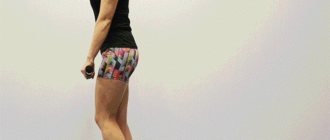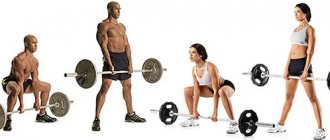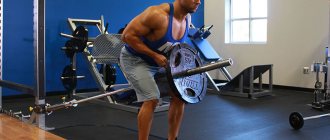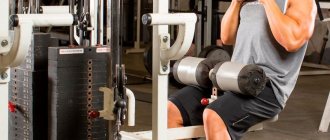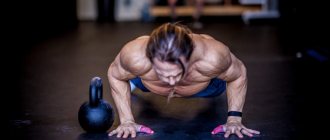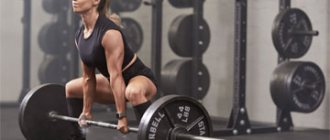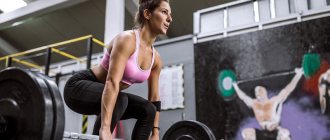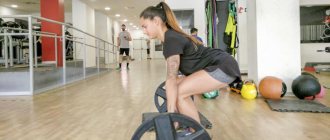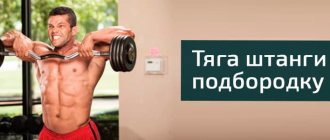Pulling weights (barbells or dumbbells) from the floor can be different. The most popular are the deadlift, Romanian, as one of the varieties of the deadlift, straight leg deadlift and a number of other modifications of this exercise. The deadlift differs in its execution technique and is suitable for beginners, as well as girls, in contrast to the same classic deadlift.
What muscles work in the exercise
When performing deadlifts with dumbbells correctly, the main load is directed to the hamstrings and buttocks .
The second number involves the lumbar muscles. By the way, if you did an approach and felt that your lower back was more tired, it means there is some kind of technical error that needs to be corrected.
In static mode, the rectus abdominis, latissimus, trapezius and forearms are included in the work. The calf muscles act as body stabilizers.
Benefits for women
For girls, this exercise is one of the main ones, as it is an irreplaceable base. It will help put the buns in order and remove excess fat.
The classic deadlift, in my opinion, is not particularly suitable for women, since it mainly loads the quadriceps, and centaurs with legs the size of a small Norwegian village are able to win the hearts of very few men.
But with the help of dead and Romanian thrust, you can grow a nut that will break the heart of half the male population of the planet. Another small nuance that will help place more emphasis on the buttocks in this exercise is to tighten the buttocks at the very beginning of the lift and push the pelvis forward with tense buttocks. But under no circumstances should you squeeze them too hard at the end point or move your pelvis too far forward.
Difference Between Deadlift and Stiff Leg Row
To answer in a nutshell, these are two different names for the same exercise. The term straight leg deadlift was more used in Russian-language literature. The name “deadlift” came to us from the USA.
The confusion in terminology comes from translation difficulties.
In American bodybuilding, all types of deadlifts are called “Deadlift”. But clarifications are added to them, for example, the Romanian deadlift or the classic deadlift (literally translated).
In Russian-speaking spaces, the word “dead” is adapted to “stanovaya” - Romanian deadlift, sumo-style deadlift, etc. But for the version with straight legs, the second name stuck – dead.
It is often confused with the Romanian, the only difference being the slight bending of the knees when performing the exercise.
A feature of the correct deadlift is performing the exercise with completely straight legs . As a rule, this option is more suitable for girls with good natural flexibility.
For men, a slight, barely noticeable bend of the legs at the knees is allowed. Just enough to remove the unpleasant tension in the popliteal ligaments.
Rounding the back
An error occurs if the athlete chose the wrong set of dumbbells, that is, did not calculate the weight. Or he simply doesn’t have the right technique.
The whole person rises not on an arched back, but “on his hump”, and accordingly, the spine is loaded. This happens in all deadlift variations.
In addition to the injuries that can occur when performing exercises with a slouched back, the effectiveness is lost by more than half.
This often happens on the first rep, meaning the athlete lifts the weight off the floor in a hunched position and then straightens up. It is recommended that when lifting, you look not forward, but a little higher, so that you instinctively have the desire to lift the barbell or dumbbells to the ceiling.
Common Mistakes
The main mistake is bending your knees too much when bending forward. As a result, instead of a dead one, it turns out to be Romanian.
The movements are similar and many gym goers don’t even understand what the difference is.
The fact is that when performing the Romanian deadlift, the lower back works almost equally with the buttocks and hamstrings. As a result, the load is distributed across three muscle groups.
To reduce the involvement of the lumbar muscles and increase the load on the gluteal muscles, it is recommended to do the straight-legged option.
The second common mistake is rounding the back when performing the exercise.
Keep your back straight throughout the entire movement! If you can’t do this, there are two options that affect this - the psoas muscles are not yet developed enough, or there is not enough flexibility at the back of the thigh.
This is easy to figure out. Strengthen your lower back with other more accessible exercises, such as hyperextensions or pumps. And pay due attention to stretching after each workout.
Don't forget about the pacing, which also has its moments. Deadlifts are done deliberately slowly, mentally focusing on contracting the gluteal muscles.
Recommendations
- The bar should be non-slippery, ideally competitive. If there is none in the hall, use straps;
- You should wrap your back in the same way as you would for a regular competition deadlift;
- The weak point of this row is the need to pull the weight from a point that is lower than usual, therefore a significant risk of rounding the back accompanies the exercise;
- It is not worth “inserting” the thoracic region rigidly because its deflection in the opposite direction leads to overload of the lower back and injury;
- The lumbar region should be rigid in the deadlift. The chest can just be slightly bent, creating the effect of a fishing rod;
- The shoulders calmly move forward and drop slightly.
Contraindications for performance
As effective as an exercise is in training the gluteal muscles, it is also dangerous for injury. Please note that the risk of injury is possible only if the technique is grossly violated or if excessively heavy dumbbells are used.
As a rule, straight leg rows with dumbbells are performed with moderate weight, so this exercise does not cause any problems.
However, there are a number of contraindications here:
- Serious diseases and injuries of the spine (especially the lumbar region)
- Injuries to muscles and ligaments that are involved in movement
- Heart and blood pressure problems
What can be replaced
There are several options for performing power traction. They have certain differences. For example, Romanian differs from dead in the following nuances:
- The knees bend.
- The movement begins with moving the pelvis back. In the dead position, the body is tilted.
- The projectile only goes down to the knees.
- When returning to the starting position, the pelvis moves forward.
There are also differences between deadlifts and classic deadlifts. In the first case, the legs remain straight, and in the second they bend. This is the only fundamentally important difference.
When training at home, this exercise can be replaced with a number of others:
- abduction of the lower limbs back with the use of weights;
- reverse hyperextension;
- leg extension with an elastic band or on a machine;
- Leg presses for the back of the thighs.
Sumo for girls would also be an excellent solution. Such training will also benefit men. To avoid injury, it is recommended to use an orthopedic belt. It is also worth considering that the hard athletic version will not help in this case.
Hyperextension
Leg extension with an elastic band or on a machine
Leg presses for the back of the thighs
We include it in our training
Introducing a simple and effective lower body workout program that includes the Romanian deadlift. Before any workout, remember to thoroughly warm up your muscles. You can modify it according to your preferences:
| Squats | 3 sets of 4-6 reps (80-85% of maximum weight) |
| Romanian deadlift | 3 sets of 4-6 reps (80-85% of maximum weight) |
| Single leg squats or lunges | 3 sets of 6-8 reps (75-80% of maximum weight) |
| Lying leg curls | 2 sets of 6-8 reps (75-80% of maximum weight) |
| Additional exercise: standing calf raises | 2 sets of 8-12 reps (70-80% of maximum weight) |
Varieties
There are different types of this exercise. Each of them has a number of distinctive features. To choose the most suitable option for yourself, the exercises should be considered in more detail.
Classical
In the classic version, deadlifts with a barbell allow you to develop back muscle tissue. The exercise is performed on bent, but very slightly, legs. You need to adhere to the following scheme:
- The body initially straightens, after which the back bends slightly.
- The chest is pushed forward.
- The shoulders move back.
- Feet are shoulder-width apart.
- The buttocks and hips move back slightly so that the bar falls without jerking or sudden movements.
- Along with the lowering of the projectile, the pelvis moves back.
- When raising the bar and lowering it, the lower back remains arched all the time.
- The bar must be lowered to the floor. After this, it is raised again, making a short delay at the level of the knees.
Speaking about how to do this exercise correctly, special attention should be paid to the grip. It is performed shoulder width apart. The palms should be directed towards the body.
Interesting Facts
Follow the correct technique, do not chase heavy working weights
The Romanian deadlift became known to the general public relatively recently. In 1990, an athlete from Romania, Niculae Vlad, was training in San Francisco.
When working the muscles of the back and legs, the athlete used a modified deadlift, in which the knees did not bend, and the bar was brought only to the upper third of the shin.
Although the exercise was not invented by Vlad Niculae himself and was not the development of his coaches, it became associated with Romanian weightlifters, which gave this type of deadlift its name.
The deadlift can be used to assess an athlete's strength - one way or another it involves all muscle groups. But in powerlifting competitions, the deadlift is used instead: it allows you to lift more weight, and is less likely to cause injury.
The leg muscles make up approximately half of the muscle mass. They need to pay a lot of attention during training. On the one hand, this will make the body proportional, on the other hand, it will contribute to the growth of the muscles of the upper body.
At the same time, many people forget about the back of the thighs and buttocks, focusing on the shins
and quadriceps, but it's really the hamstrings and glutes that need to be given ample time.
No other exercise has such an effect on the development of these muscles as the deadlift.
Deadlift records
One way or another, the current absolute record in deadlift belongs to Icelander Benedikt Magnusson (weight category over 140 kg). He conquered 460 kg. There are two more equally impressive records, but they were performed using straps and overalls. However, this does not detract from their importance:
Briton Eddie Hall conquered 500 kg (weight category over 140 kg), watch the epic video of this event below; Russian Yuri Belkin won 450 kg (ATTENTION, weight category up to 110 kg).
Which of these is more significant for the development of sports as a whole and setting the right example for novice athletes, decide for yourself. My opinion is the following: Belkin’s result is simply space. We wish the athlete to set new world records and avoid injuries.
Training program
How many sets and reps should you perform? One of the most frequent and pressing questions. Unfortunately, there is no clear answer to this. The effectiveness of the exercise depends on the goals and objectives of the trainee:
- When gaining weight. It is better to perform the exercise on a separate day. Number of approaches: 5-6. Repeats: 8-12 times. If you combine it with a back day, you can reduce the number of approaches.
- When increasing endurance. Can be done both on leg and back day. Number of approaches: 3-6. Repeats: 12-20 times.
In general, the training program should be drawn up by an experienced trainer, taking into account the gender, age and physical capabilities of the trainee. And also, possible pathologies and health problems. Therefore, only a competent trainer will help you create an effective training program that will produce results.
Is it possible to combine deadlifts and squats on the same day? It all depends on the goals and objectives. If you plan to deadlift a lot of weight, it’s better to do it on a separate day. And if it is performed as a strengthening exercise after squats, then you can take a light weight and do 3-4 approaches.
Muscles involved
The classic deadlift with dumbbells or barbell is a basic exercise. It is believed that 90-94% of the muscles of the whole body are involved when performing.
The load is static in nature, but you should not detract from the merits of the exercise because of this. As for dynamic, its effect varies depending on the type of exercise.
Classic version
The quadriceps femoris, buttocks and group of spinal extensor muscles (spinous, iliocostal and longissimus) are worked out.
The development of the latter is especially important: inflated “pillars” protect the spine from injuries during stress and lift the latissimus muscles from the inside, visually increasing the width of the athlete’s back
Sumo
First of all, the adductors of the thighs are tensed - they are located on the inner surface of the thigh, forming a layer of tissue responsible for pulling the legs to the middle of the body. Adductors are a group of adductor fibers consisting of the long, brevis, pectineus, gracilis and major muscles.
In addition to the above, the buttocks and quadriceps are loaded. The spinal extensors are less loaded, and the hamstrings are responsible for balancing the body when performing deadlifts.
Romanian deadlift
The technique involves working the buttocks and biceps femoris, which take on the lion's share of the dynamic load. Unlike the above methods, the quadriceps is not involved.
In any technique, balance is maintained by tightening the calf muscles, abdominal muscles and upper back (trapezius, lats and rhomboids).
How to do it right
To achieve results, it is important to perform the exercises correctly. Let's talk in more detail about the technique of performing deadlifts... Important! Before starting any workout, be sure to stretch to warm up all your muscles.
Important! Before starting any workout, be sure to stretch to warm up all your muscles.
Grip width and leg position
Many novice athletes are interested in how best to grip the apparatus.
In this case, three options are suitable:
- direct grip - when the wrists are turned towards the body;
- reverse, or “female” grip - in which the wrists look outward;
- multidirectional - it combines both of the above types.
Which one to choose is up to everyone to decide for themselves. As for the position for the legs, the feet should be placed shoulder width apart or even slightly narrower. The toes are slightly turned outward.
Execution technique
When the athlete has taken the apparatus and taken the correct position, his next steps will be the following:
- We straighten our back, bringing our shoulder blades together.
- We bend slightly in the lumbar region, moving the pelvis back.
- Don’t forget to breathe: inhale when descending and exhale when lifting the projectile.
- Raise the projectile to shoulder level.
- Now we begin to move the projectile straight down, trying to reach the feet.
- While bending, we maintain a straight back, but we lower ourselves by bending the lower back and abducting the pelvis.
- At the same time, we keep the legs straight, but as they tilt, they, together with the pelvis, can be slightly retracted back. During the exercise, you should feel the muscles of the lower back and back of the thigh working.
- Having reached the maximum point of inclination, we begin to slowly climb back. Returning to the starting point, we bring the shoulder blades together.
Video: deadlift technique
At first, until flexibility is sufficiently developed, the athlete will not be able to lower the barbell below the knees. As for girls, it is better for them to start practicing this exercise with an empty apparatus.
However, do not expect to lift more weight with the deadlift, even after some time. This exercise only works the lower back and back of the thigh, which are not physically designed for significant loads.
Learn how to do barbell glute lunges and barbell shrugs, how to properly do barbell back squats, as well as barbell front squats and barbell Romanian deadlifts.
Number of approaches and repetitions
These two parameters directly depend on the athlete’s training goal:
- if the emphasis is on endurance, then you need to do 4 sets with 12 or more repetitions;
- for muscle growth, 3-4 approaches with 5-12 repetitions will be enough;
- strength work involves at least 4–5 approaches, each of which contains 5–6 repetitions.
Romanian deadlift technique with dumbbells
- Take dumbbells in your hands, place your feet parallel to the width of your pelvis. Place the dumbbells on your hips with your arms outstretched, with your palms facing you.
- As you inhale, move your pelvis back, transferring your body weight to your heels, while slightly bending your legs at the knee joints and stretching your hamstrings. Look straight ahead.
- The lowest point of the amplitude will be determined by the degree of flexibility of the hamstring biceps, but in no case should you go lower due to rounding the back. The dumbbells should reach approximately mid-calf.
- As you exhale, straighten your torso by tensing your gluteal muscles and lower back. Push off with your heels and return to the starting position with your back straight.
Basic mistakes when doing exercises
Mistakes occur due to poor preparation, poor stretching and inattention when performing deadlifts. That is why the warm-up needs to be done as thoroughly as possible. During the exercise, you need to carefully listen to which muscles are tense in order to regulate the position of the body.
The most common mistakes:
- Bend your knees. On the one hand, you don’t need to straighten your knees all the way, but on the other hand, they need to be left in a straight position in order to perform deadlifts, and not variations on the Romanian theme. To straighten you need a good stretch. It is optimal to prepare for performing exercises on a hyperextension machine.
- Lowering the head. You have to look straight ahead. It is convenient to practice in front of a mirror, so mistakes will be obvious.
- Arching, rounding of the lower back. As soon as you let go of your lower back, your entire back begins to round. This may cause injury. The weight is lifted by the entire back, not just the lower back, so you need to pay attention to the position of the lower back.
- Incorrect shoulder position. Deadlifts cannot be combined with shrugs; the shoulders must be straightened from the starting position. Try to fix them at the beginning of the exercise and not move them, as this interferes with the pumping of the necessary muscles and can also cause injury.
